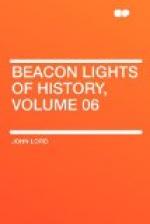and their health. In a very short time after the
accession of Elizabeth, which was hailed generally
as a very auspicious event, things were restored to
nearly the state in which they were left by Cranmer
in the preceding reign. This was not done by direct
authority of the Queen, but by acts of Parliament.
Even Henry VIII. ruled through the Parliament, only
it was his tool and instrument. Elizabeth consulted
its wishes as the representation of the nation, for
she aimed to rule by the affections of her people.
But she recommended the Parliament to conciliatory
measures; to avoid extremes; to drop offensive epithets,
like “papist” and “heretic;”
to go as far as the wants of the nation required,
and no farther. Though a zealous Protestant, she
seemed to have no great animosities. Her particular
aversion was Bonner,—the violent, blood-thirsty,
narrow-minded Bishop of London, who was deprived of
his see and shut up in the Tower, put out of harm’s
way, not cruelly treated,—he was not even
deprived of his good dinners. She appointed,
as her prerogative allowed, a very gentle, moderate,
broad, kind-hearted man to be Archbishop of Canterbury,—Parker,
who had been chaplain to her mother, and who was highly
esteemed by Burleigh and Nicholas Bacon, her most
influential ministers. Parliament confirmed the
old act, passed during the reign of Henry VIII., making
the sovereign the head of the English Church, although
the title of “supreme head” was left out
in the oath of allegiance, to conciliate the Catholic
party. To execute this supremacy, the Court of
High Commission was established,—afterwards
so abused by Charles I. The Church Service was modified,
and the Act of Uniformity was passed by Parliament,
after considerable debate. The changes were all
made in the spirit of moderation, and few suffered
beyond a deprivation of their sees or livings for
refusing to take the oath of supremacy.
Then followed the Thirty-nine Articles, setting forth
the creed of the Established Church,—substantially
the creed which Cranmer had made,—and a
new translation of the Bible, and the regulation of
ecclesiastical courts.
But whatever was done was in good taste,—marked
by good sense and moderation,—to preserve
decency and decorum, and repress all extremes of superstition
and license. The clergy preached in a black gown
and Genevan bands, using the surplice only in the
liturgy; we see no lace or millinery. The churches
were stripped of images, the pulpits became high and
prominent, the altars were changed to communion-tables
without candles and symbols. There was not much
account made of singing, for the lyric version of
the Psalms was execrable. For the first time since
Chrysostom and Gregory Nazianzen, preaching became
the chief duty of the clergyman; and his sermons were
long, for the people were greedy of instruction, and
were not critical of artistic merits. Among other
things of note, the exiles were recalled, who brought
back with them the learning of the Continent and the
theology of Geneva, and an intense hatred for all
the old forms of superstition,—images, crucifixes,
lighted candles, Catholic vestments,—and
a supreme regard for the authority of the Scriptures,
rather than the authority of the Church.




